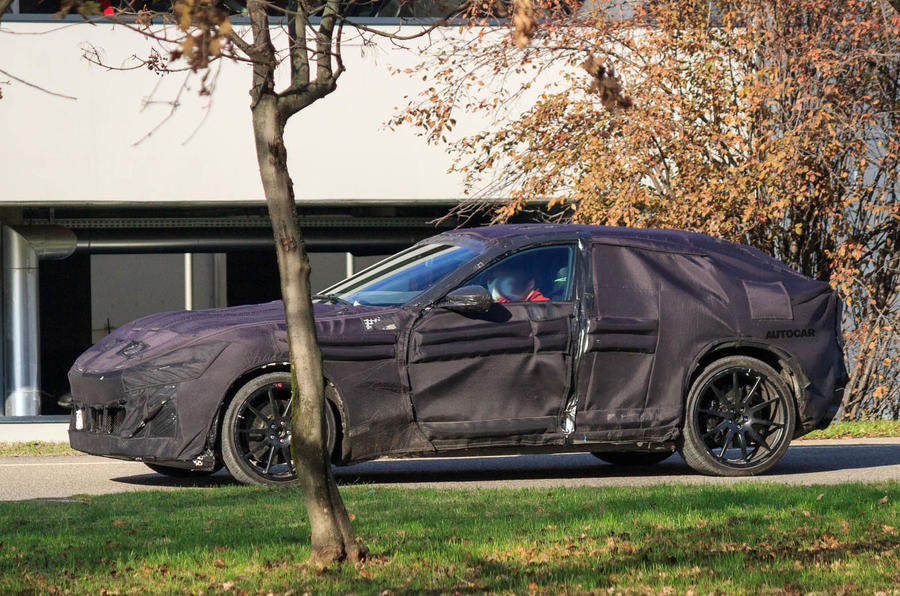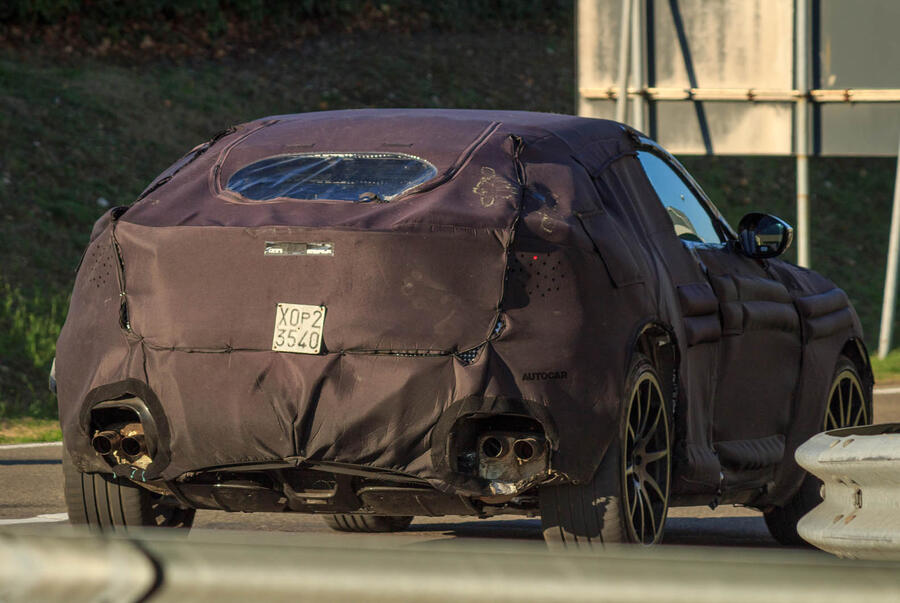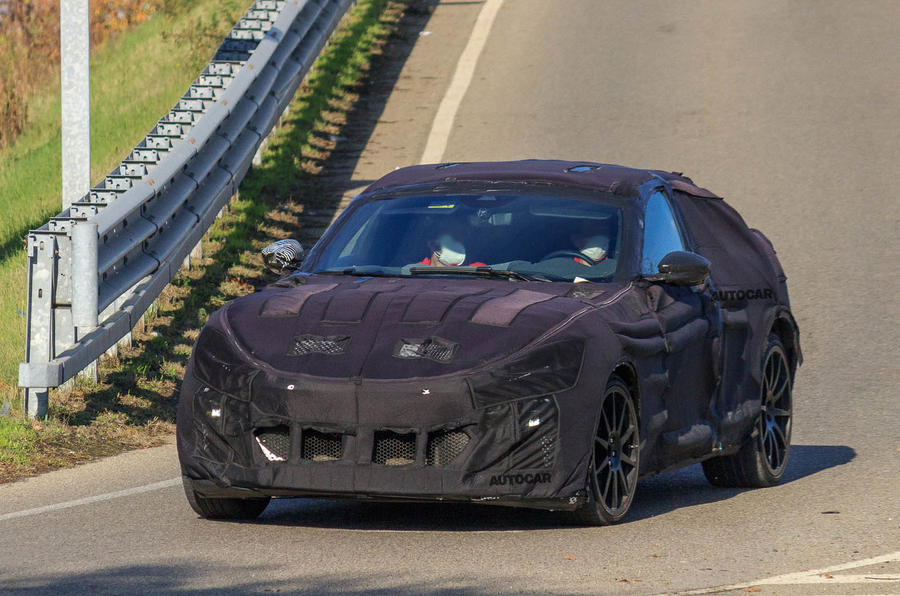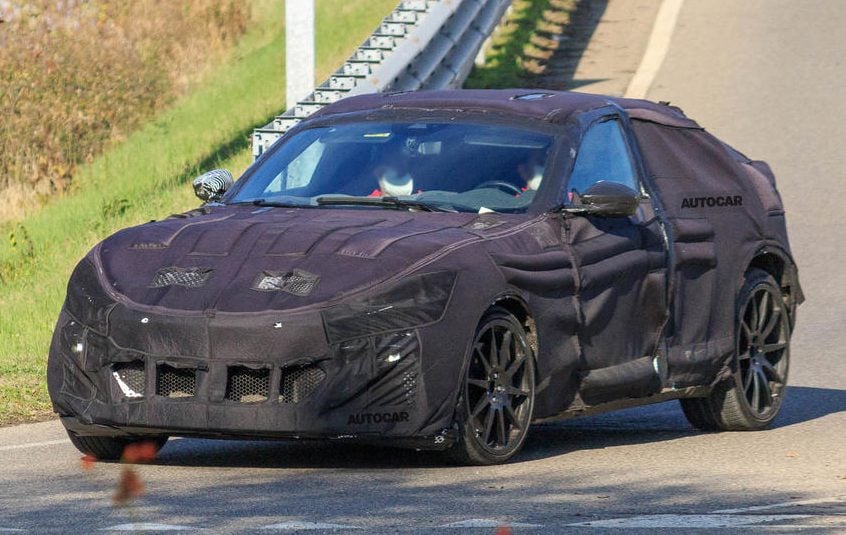 Ferrari is preparing to enter the performance SUV ring in 2022 – and new images shared on social media (below) look to preview the SUV’s styling ahead of its official unveiling later this year.
Ferrari is preparing to enter the performance SUV ring in 2022 – and new images shared on social media (below) look to preview the SUV’s styling ahead of its official unveiling later this year.
First spotted on Instagram and since shared more widely, the pictures – which allegedly show the Purosangue’s front and rear – look to have been taken inside a private facility. Ferrari has refused to comment, and it is unclear where they were originally posted.
As hinted at by production-spec prototypes, which hit the road late last year, the Purosangue looks to feature a more overtly GT-inspired silhouette than other cars in its segment. The front features C-shaped headlights like those worn by the Ferrari SF90 and the distinctive rear light bar appears similar to that of the Ferrari Roma coupé.Short overhangs and a long, low bonnet are among its other defining characteristics, hinting at a maintained focus on big power and keen handling for Maranello’s first SUV.
Importantly, the low leading edge of the bonnet hints at an engine that has been pushed further back into the chassis for improved weight distribution, in a front mid-engined set-up reminiscent of the lower-slung 812 Superfast grand tourer.
Due later this year and being developed under the codename Purosangue, which translates from Italian as ‘thoroughbred’, the new Ferrari promises to be like no other performance or ultra-luxury SUV on the market, thanks to different positioning from the likes of the Aston Martin DBX, Bentley Bentayga, Lamborghini Urus and Rolls-Royce Cullinan.
The SUV, also known internally as 175, is one of 15 new Ferraris announced last year and set to be launched by 2023. They will be built off two bespoke architectures giving two distinct model lines, one for mid-engined supercars, such as the F8 Tributo, and the other for front-mid-engined GT-style cars, including the new SUV.
 “I’m convinced on this car and the technical concept,” Ferrari’s then chief technical officer, Michael Leiters, told Automotive Daily’s exclusive partner Autocar in 2019. “I think we’ve found a concept and a package which is on one side a real SUV and will convince SUV customers to buy it, but on the other side there’s a huge differentiation of concept to existing SUVs.”
“I’m convinced on this car and the technical concept,” Ferrari’s then chief technical officer, Michael Leiters, told Automotive Daily’s exclusive partner Autocar in 2019. “I think we’ve found a concept and a package which is on one side a real SUV and will convince SUV customers to buy it, but on the other side there’s a huge differentiation of concept to existing SUVs.”
That concept is based around Ferrari’s ability to mix a bespoke architecture (as opposed to one shared across a wider group, such as the Volkswagen Touareg and Audi Q7-derived MLB platform used by the Bentayga and Urus) that not only endows the car with Ferrari levels of performance and dynamic ability but also the space, comfort and user-friendly cabin required of an SUV.

“The challenge is to open a new segment for Ferrari,” said Leiters. “We always have very, very sharp positioning. It helps to develop cars in a certain, focused manner and easily decide certain trade-offs.
“The trade-off decision is totally different for us here. We will have totally new engineering challenges.”
Ferrari remains tight-lipped on the Purosangue’s specifics but is happy to discuss the theory and challenges behind pushing the brand in its most radical direction yet in its illustrious 72-year history.
 It’s known that the SUV’s design has been signed off and the car will employ Ferrari’s scalable front-mid-engined architecture, one of two highly flexible structures that will underpin Ferrari’s future range.
It’s known that the SUV’s design has been signed off and the car will employ Ferrari’s scalable front-mid-engined architecture, one of two highly flexible structures that will underpin Ferrari’s future range.
Both architectures, the other supporting a traditional mid-engined layout, are able to accommodate V6, V8 and V12 engines, with or without hybrid assistance and with a transaxle dual-clutch automatic gearbox; rear or four-wheel drive; two, two-plus-two or four-seat cabins from variable-wheelbase lengths.
From these wide-ranging parameters, the SUV will take the form of a four-seater with a length of around five metres, and its high ground clearance is likely to be achieved through height-adjustable suspension and an anti-roll system to allow for impressive on-road dynamics and some off-road ability. Plug-in hybrid technology is also set to feature as pressure grows to cut emissions, with the powertrain to be derived from that of the new V6-powered Ferrari 296 GTB, though a version of the electrified V8 used by the SF90 is on the cards.
A range-topping V12 version is also considered likely, as Ferrari remains committed to the development of V12 engines.
“SF90 is a new product with so many new innovations on the car, then we find the elements to go onto other cars,” said Leiters, on the technology transfer from the SF90 Stradale to other models. “The challenge [with the SUV] is a totally different one. There are some innovations to go on, but our organisation has learned to do innovation,” he added, in reference to the likelihood of the Purosangue featuring innovations of its own.

All the Ferrari GT models, including the SUV, will get a completely new interior layout based around what it calls an ‘eyes on the road, hands on the wheel’ approach. Among the features will be a new steering wheel design, new infotainment, a head-up display, new instruments, new ways of operating the cabin controls, rear-seat entertainment and improved ingress and egress.
Leiters also detailed some of the engineering challenges being faced while Ferrari develops its first SUV.
He said: “With space, how can we ensure that there is the right easy, ergonomic comfort on board? How to combine the sporty layout with a more comfort-orientated design? What to do with HMI [human machine interface]? Our HMI is driver-orientated, but how can it be more democratic? What are the comfort features? What is a Ferrari’s pure DNA on a car for comfort?
“It’s a challenge, an opportunity and fun. I like it very much. Some concepts are close together, but with cars like 175 one thing we want to do is structure the product range and have something different.”
Leiters said the two new architectures provided much greater flexibility between future Ferrari models.
“We’ve not said there definitely will be V6s or V12s but we have foreseen it,” he said. “My job is to give the company an opportunity for models. Then they tell us what they need from a market point of view.
“In the function of different customer requirements, do we need space? Six or eight cylinders? A long wheelbase? So we can offer V6, V8, V12, front- or mid-engined, hybrid or not, two-wheel drive or four-wheel drive, 2+0, 2+2 or four seats; vary the wheelbase a lot. We’re able to manage very easily and have a very low impact doing it.”
Head of design Flavio Manzoni said the designers had been working with engineering right from the start to ensure optimum proportions for what is set to be a controversial model for the brand.
“You start defining the design of the car in the first steps,” he said. “In that defining phase we work with the engineers. We can determine the proportions and the dimensions to have a very good base to work from. That’s the case for the SUV as well. Many SUVs are derivatives of other cars. Designers have many constraints due to the technical base. In our case, it’s no compromise.
“If we don’t start together with engineers, defining together with the package, it’s a problem. I praise a lot of the collaborations when we start a new project.”
Mark Tisshaw




 Ferrari is preparing to enter the performance SUV ring in 2022 – and new images shared on social media (below) look to preview the SUV’s styling ahead of its official unveiling later this year.
Ferrari is preparing to enter the performance SUV ring in 2022 – and new images shared on social media (below) look to preview the SUV’s styling ahead of its official unveiling later this year.